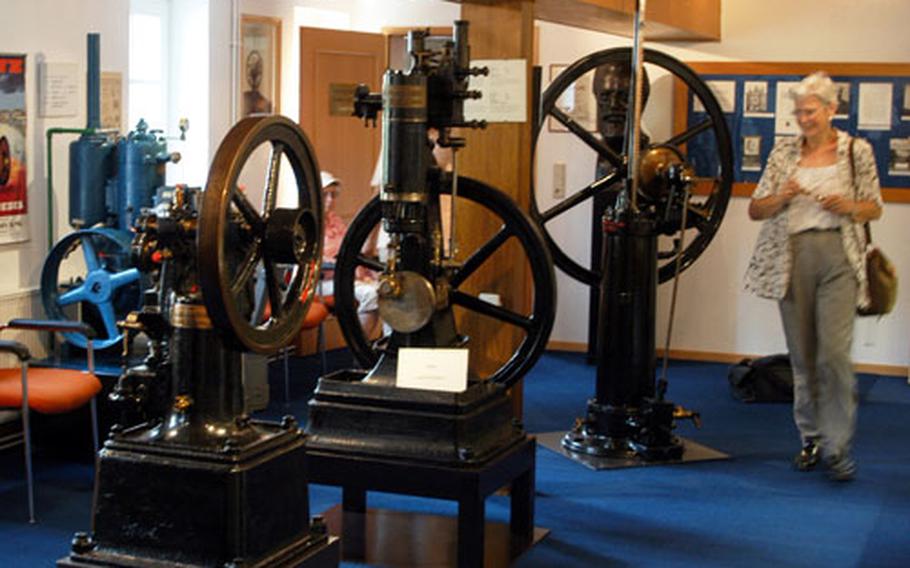
A visitor studies the first Otto motor displayed in the main room of the Nicolaus August Otto Museum in Holzhausen, Germany. (Peter Jaeger / S&S)
You wouldn’t have wheels without him.
Nicolaus August Otto invented the four-cycle combustion motor in 1861, the forerunner of today’s gasoline motors for automobiles.
His invention was so important for the industrial age — Gottlieb Daimler used it to help develop the first gas-powered car — that he is still honored on every German vehicle registration for a car that does not have a diesel engine. In the specifications on the registration certificate for gas cars is the word “Otto.”
Otto was born in Holzhausen an der Haide, Germany, in 1832. Four rooms in the house of his birth in the tiny village 20 miles north of Wiesbaden now house a museum named after him: the Nicolaus August Otto Museum. It is definitely worth a visit for car buffs.
The museum’s building is owned by the community, and the museum is operated by a local organization called the Oldtimer Club, which was founded in 1991 for the express purpose of saving the house and expanding its exhibit area from a single room to the entire ground floor.
Among the exhibits are about 20 engines, including Otto’s first four-cycle cylinder engine. Many of them were produced by Deutz, a German manufacturing company, and were obtained and repaired by club members. The oldest is from 1877.
It is a pleasure just to look at the engines: The sheer beauty and simplicity of these early mechanical masterpieces almost transforms them into technical sculptures.
Even in its early years in the 19th century, the engine ran so smoothly that customers in the States and England, where it was also used, praised it as “Silent Otto.” It became the engine’s nickname.
Personal documents, photos of Otto’s life, advertising fliers and information about the club — about 60 items in all — round out the small but impressive exhibition.
Otto began his career as a salesman but was very interested in technical things. He taught himself about existing motors and machines and went about inventing others. He founded his own firm in Cologne and produced — after some initial problems — stationary machines for the industry.
His most-famous engine originally worked with natural gas, and later with petroleum and gasoline. Co-workers Wilhelm Maybach and Daimler later put Otto’s invention in their first automobiles.
There are no English-language descriptions or folders for the museum, and the friendly curator, Erna Tollkiehn, speaks only German.
That is unfortunate for visitors who cannot understand her. At age 86, she’s still energetic and full of wit and humor — and she’s very knowledgeable on technical details about Otto’s inventions. She has worked with the exhibits for more than 40 years.
But if you don’t speak German, don’t worry. The exhibition and the displays speak for themselves. And for those who want to learn more, a festival will be held at the museum Sunday starting at 10 a.m. Among those sure to be present will be lots of Oldtimer Club members who speak English, know the subject and will probably be glad to answer any questions.
On the QTDIRECTIONS: From the Frankfurt-Wiesbaden area, take A66 west — it changes to Highway 42 — to Route 260 and follow it toward Bad Ems. Holzhausen is 20 miles away. From the Kaiserslautern area, take A63 toward Mainz, then switch to A60 and A643 toward Wiesbaden and then A66 toward Rüdesheim, and follow directions above. The museum is on the main road in the center of town.
TIMES: The museum is open 10 a.m. to 4 p.m. daily. Ring bell for entrance; the curator lives in the building.
COSTS: Entrance and parking are free.
FOOD: Three German restaurants and a pizzeria are close to the museum.
INFORMATION: The Oldtimer Club supports the museum, and has information on its Web site, http://nicolaus-august-otto.de. Visitors can also contact club official Günther Klose at guenther.klos@nicolaus-august-otto.de or by telephone at 06722-8366. He speaks enough English to answer questions about the exhibit, and can help arrange Sunday tours.
— Peter Jaeger